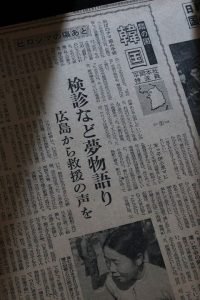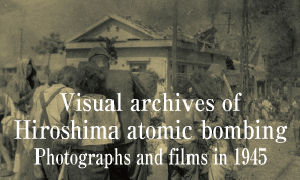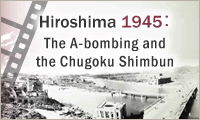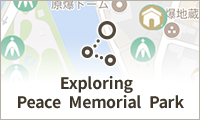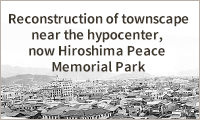Documenting Hiroshima 80 years after A-bombing: In November 1965, A-bomb survivors in South Korea interviewed
Apr. 14, 2025
Korean A-bomb survivors requested treatment one after another
by Minami Yamashita, Staff Writer
In November 1965, Takashi Hiraoka, now 97 and living in Hiroshima’s Nishi Ward, was a 37-year-old senior staff writer at the Chugoku Shimbun. He had traveled to South Korea for the first time since the war ended and visited survivors of the atomic bombing of Hiroshima. They were living in densely packed shacks on the riverbanks of the Cheonggycheon Stream in the center of Seoul. Each survivor complained that neither Japan nor South Korea provided support, requesting: “We want to be treated.”
Five years prior, the editorial department received a letter written in Japanese from a hospitalized man in Masan, South Korea. In the letter, he said he had been exposed to the atomic bombing in Hiroshima and needed support.
Traveled to South Korea at his own expense
Mr. Hiraoka, who saw the end of the war while living on the Korean Peninsula where his father was in the coal business, was more interested in South Korea than most people. “Due to the discriminatory sentiments Japanese people harbored against people from the Korean Peninsula at that time, the Japanese showed little social interest in Korean atomic bomb survivors. They thought only Japanese people were exposed to the atomic bombings. I thought we had to do something to respond to their appeal when I read the letter,” he said. After finishing the series “20 Years After the Bombing,” he flew to South Korea at his own expense.
At that time, the South Korean government had conducted a survey and concluded 203 Korean atomic bomb survivors were living in the country. However, the real state of affairs was unknown. In May 1965, the Hiroshima head office of the Korean Residents Union in Japan sent a delegation to South Korea. The delegation requested the South Korean government investigate the actual situation of the survivors and undergo relief measures for them. According to an article in the Chugoku Shimbun on July 28, South Korea’s social and health department and the Korean Red Cross had already begun a reinvestigation to find out more about their conditions.
As Japan was about to normalize diplomatic relations with South Korea, Mr. Hiraoka developed a plan for a series focusing on the country’s current situation, including its politics, culture, and the economy. However, he spent much of his 15-day stay in South Korea conducting interviews with atomic bomb survivors. Relying on a list of names kept by the Korean Red Cross, he walked around Seoul and Busan looking for survivors and was able to meet nine of them.
A woman he saw in a poor residential area of Seoul had a keloid scar that ran from her face down to the nape of her neck. She was a sixth grader at a national school when she experienced the atomic bombing while riding a streetcar on Miyuki Bridge. She stole her aunt’s chima (skirt) and managed to raise money for surgery, but the scar remained. She had three miscarriages and suffered from repeated dizziness, but the people around her did not understand her condition. Seeing a doctor was also difficult because of the cost.
Raised awareness of the issue
“For Koreans, the U.S. atomic bombings occurred outside of their country. There was also a historical view that the atomic bombings freed them. For these reasons, Korean survivors were neglected in South Korea.” Mr. Hiraoka raised awareness of this issue. After he returned to Japan, his “South Korea, Our Neighbor” appeared in ten installments, starting on November 25, 1965. In the last two articles of the series, headlined “Having a medical examination is a pipe dream” and “600 survivors awaiting treatment,” he conveyed the dire situation of the survivors in South Korea.
Even after that, Mr. Hiraoka traveled to South Korea and continued covering the Korean survivors. He said: “In war, aggressors and victims are mixed. Through people who were abandoned by their own country, such as the atomic bomb survivors in South Korea, I have been thinking about what a state is.”
At that time, the situation of atomic bomb survivors living in U.S.-governed Okinawa was the same as that of South Korean survivors: they were unable to receive aid from the Japanese government. In 1963, when it was said that “there were no atomic bomb survivors in Okinawa,” a fact-finding survey began after a woman in Ishigaki Island, who had experienced the bombing in Hiroshima, complained to the local council against atomic and hydrogen bombs about her health concerns.
From August to September of 1964, Minoru Omuta (died in 2001 at the age of 71), a staff writer for the Chugoku Shimbun, worked on an 11-part series titled “The Atomic Bomb Survivors of Okinawa.” He was among the first to inform the public about atomic bomb survivors in Okinawa who were not covered by the Atomic Bomb Medical Relief Law and who lived in an environment without medical specialists.
(Originally published on April 14, 2025)

